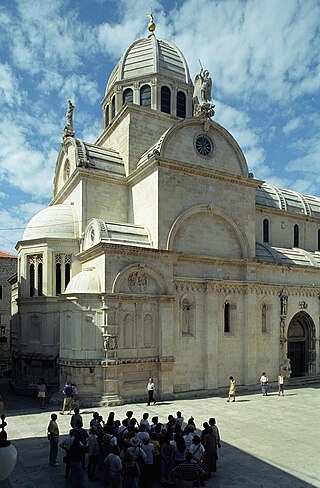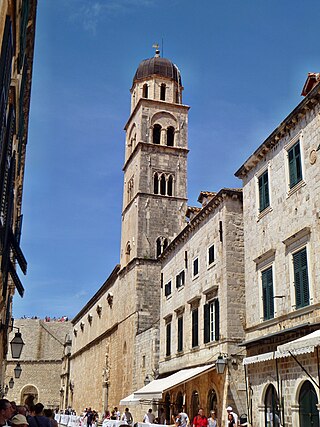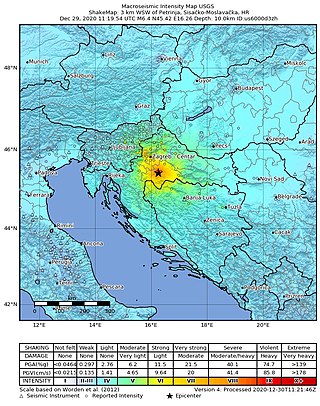
Dubrovnik, historically known as Ragusa, is a city in southern Dalmatia, Croatia, by the Adriatic Sea. It is one of the most prominent tourist destinations in the Mediterranean, a seaport and the centre of the Dubrovnik-Neretva County. Its total population is 41,562. In 1979, the city of Dubrovnik was added to the UNESCO list of World Heritage Sites in recognition of its outstanding medieval architecture and fortified old town.

Ston is a settlement and a municipality in the Dubrovnik-Neretva County of Croatia, located at the south of isthmus of the Pelješac peninsula.

The Sacred Heart Cathedral is a Catholic church in Sarajevo; commonly referred as the Sarajevo Cathedral, it is the largest cathedral in Bosnia and Herzegovina. It is the seat of the Archbishop of Vrhbosna, currently Tomo Vukšić, and center of Catholic worship in the city. The cathedral is located in the city's Old Town district.

The Diocese of Dubrovnik ; or Ragusa is a Latin Church ecclesiastical territory or diocese of the Catholic Church in southern Croatia. The diocese is centred in the city of Dubrovnik. It was first erected in 990. From 1120 to 1828 it was elevated to the status of archdiocese. By papal bull Locum Beati Petri it was degraded to the level of a diocese in 1828.

Cavtat is a village in the Dubrovnik-Neretva County of Croatia. It is on the Adriatic Sea coast 15 kilometres south of Dubrovnik and is the centre and the main settlement of Konavle municipality.

The Zagreb Cathedral, is a Catholic cathedral in Kaptol, Zagreb. It is the second tallest building in Croatia and the most monumental sacral building of Gothic architecture southeast of the Alps.

Ivan Krstitelj Rabljanin was a cannon and bell founder in bronze; born in Rab, most of his works are in Dubrovnik.

The Cathedral of Saint Tryphon in Kotor, Montenegro, is one of two Roman Catholic cathedrals in Montenegro. It is the seat of the Roman Catholic Diocese of Kotor, which covers the entire Bay of Kotor and Municipality of Budva.

The siege of Dubrovnik was a military engagement fought between the Yugoslav People's Army (JNA) and Croatian forces defending the city of Dubrovnik and its surroundings during the Croatian War of Independence. The JNA started its advance on 1 October 1991, and by late October, it had captured virtually all the land between the Pelješac and Prevlaka peninsulas on the coast of the Adriatic Sea, with the exception of Dubrovnik itself. The siege was accompanied by a Yugoslav Navy blockade. The JNA's bombardment of Dubrovnik, including that of the Old Town—a UNESCO World Heritage Site—culminated on 6 December 1991. The bombardment provoked international condemnation, and became a public relations disaster for Serbia and Montenegro, contributing to their diplomatic and economic isolation, as well as the international recognition of Croatia's independence. In May 1992, the JNA retreated to Bosnia and Herzegovina, less than 1 kilometre from the coast in some places, and handed over its equipment to the newly formed Army of Republika Srpska (VRS). During this time, the Croatian Army (HV) attacked from the west and pushed back the JNA/VRS from the areas east of Dubrovnik, both in Croatia and in Bosnia and Herzegovina, and by the end of May linked up with the HV unit defending the city. Fighting between the HV and Yugoslav troops east of Dubrovnik gradually died down.

The Assumption Cathedral is a Roman Catholic cathedral in Dubrovnik, Croatia. It is the seat of the Diocese of Dubrovnik.

The architecture of Croatia has roots in a long history: the Croats have inhabited the area for fourteen centuries, but there are important remnants of earlier periods still preserved in the country. The historic architecture of most old towns on the coast is Venetian, a legacy of the Venetian empire. The Habsburg and Ottoman empires also influenced the architecture of the region.
The 1979 Montenegro earthquake occurred on 15 April at 06:19 UTC with a moment magnitude of 6.9 and a maximum Mercalli intensity of X (Extreme). It was the most devastating earthquake in SR Montenegro, then part of Yugoslavia, and was mostly felt along the Montenegrin and Albanian coastline. It was also felt in other parts of the country.

The Walls of Dubrovnik are a series of defensive stone walls surrounding the city of Dubrovnik in southern Croatia. Ramparts were built in the outlying areas of the city, including the mountain slopes as part of a set of statues from 1272. The existing city walls were constructed mainly during the 13th–17th centuries. The walls run an uninterrupted course of approximately 1,940 metres (6,360 ft) in length, encircling most of the old city, and reach a maximum height of about 25 metres (82 ft).
The 1667 Dubrovnik earthquake was one of the three most devastating earthquakes to hit what is now modern Croatia in the last 2,400 years, since records began. The entire city was almost destroyed and around 3,000 to 5,000 people were killed. The city's Rector Simone Ghetaldi was killed and over three quarters of all public buildings were destroyed. At the time, Dubrovnik was the capital of the Republic of Ragusa. The earthquake marked the beginning of the end of the Republic.

Stradun or Placa, whose name derives from Venetian, and means "large road" or "wide road", is the main street of Dubrovnik, Croatia. The limestone-paved pedestrian street runs some 300 metres through the Old Town, the historic part of the city surrounded by the Walls of Dubrovnik.

The Church of St. Mark is the parish church of old Zagreb, Croatia, located in St. Mark's Square. It is one of the oldest architectural monuments in Zagreb.

The Rector's Palace is a palace in the city of Dubrovnik that used to serve as the seat of the Rector of the Republic of Ragusa between the 14th century and 1808. It was also the seat of the Minor Council and the state administration. Furthermore, it housed an armoury, the powder magazine, the watch house and a prison.

The Franciscan friary and church is a large complex belonging to the Order of the Friars Minor. It consists of a friary, a church, a library, and a pharmacy. It is situated at the Placa, the main street of Dubrovnik, Croatia.

Messina Cathedral is a Roman Catholic cathedral located in Messina, Sicily. Formerly the episcopal seat of the Diocese of Messina, it became in 1986 the archiepiscopal seat of the Archdiocese of Messina-Lipari-Santa Lucia del Mela.

At 12:19 PM CET on 29 December 2020, an earthquake of magnitude 6.4 hit central Croatia, with an epicenter located roughly 3 km (1.9 mi) west-southwest of Petrinja. The maximum felt intensity was estimated at VIII to IX (Destructive) on the European macroseismic scale. Before this event there were three foreshocks, the strongest of which had a magnitude of 5.2 on the day before. The earthquake was followed by numerous aftershocks, the strongest of which had a magnitude of 4.9 .



















